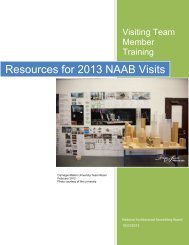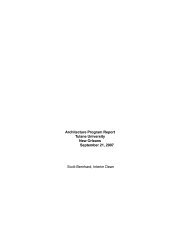NAAB Architecture Program Report (APR) 2013 - Tulane School of ...
NAAB Architecture Program Report (APR) 2013 - Tulane School of ...
NAAB Architecture Program Report (APR) 2013 - Tulane School of ...
Create successful ePaper yourself
Turn your PDF publications into a flip-book with our unique Google optimized e-Paper software.
<strong>Tulane</strong> University<strong>Architecture</strong> <strong>Program</strong> <strong>Report</strong>September <strong>2013</strong>Other Degree <strong>Program</strong>s Offered in the <strong>Tulane</strong> <strong>School</strong> <strong>of</strong> <strong>Architecture</strong>Master <strong>of</strong> Sustainable Research Development (MSRED)http://architecture.tulane.edu/programs/degrees/master-sustainable-real-estate-developmentSustainability and development go hand in hand and building green has become the norm in manycities. The tools to develop in this changing marketplace must include strategies for addressing theeconomics, community and the environment as building and rebuilding communities, towns and citiestakes place. The program prepares post-baccalaureate students from diverse fields to explore andvalue the regenerative development <strong>of</strong> cities. By providing a blended education in business, sustainabledesign, economics and legal issues, graduates are empowered to become effective and influentialparticipants and contributors in the fields <strong>of</strong> real estate, finance, development, and design. As apractitioner-oriented degree, it identifies and builds opportunities for graduates to work in for-pr<strong>of</strong>it andnon-pr<strong>of</strong>it business settings that produce innovative strategies for sustainable development. Theprogram supports and encourages nationally significant research utilizing lessons from New Orleans asa laboratory <strong>of</strong> larger implications for other communities; and draws from case study examples acrossthe United States exploring the power <strong>of</strong> public-private partnerships, innovative financing strategies andthe integrated design process <strong>of</strong>fering global strategies for lasting sustainability. Christopher Calott AIAis the new director <strong>of</strong> the MSRED program.Master <strong>of</strong> Preservation Studies (MPS)http://architecture.tulane.edu/programs/degrees/mps-master-preservation-studiesThe Master <strong>of</strong> Preservation Studies (MPS) program at the <strong>Tulane</strong> <strong>School</strong> <strong>of</strong> <strong>Architecture</strong> <strong>of</strong>fers aninterdisciplinary opportunity to learning about urban preservation in one <strong>of</strong> America’s most historiccities. New Orleans maintains a wealth <strong>of</strong> experience in architectural heritage protection resulting fromits over seventy years <strong>of</strong> historic preservation legislation and its history <strong>of</strong> preservation achievements.The MPS program was founded by architect and preservationist Eugene Cizek, Ph.D. in 1996, withguidance and support from the noted American preservation educator James Marston Fitch, who alsoattended <strong>Tulane</strong>’s <strong>School</strong> <strong>of</strong> <strong>Architecture</strong>. Since July 2011, the MPS program has been directed byJohn Stubbs, international conservation practitioner, former director <strong>of</strong> field projects for the WorldMonuments Fund, and teacher <strong>of</strong> preservation theory and practice at Columbia University for over 20years. Students from varied backgrounds are accepted in the MPS program and the majority <strong>of</strong> itsgraduates work in a variety <strong>of</strong> positions in the U.S. and abroad. A <strong>Tulane</strong> Preservation Alumni Groupwas organized in 2011 and a biennial Preservation Matters symposium addresses new directions in thefield. The MPS program has four principal tracks <strong>of</strong> learning: preservation planning, technology,methodology, and architectural history. Its course work may be accomplished in three semesters: two <strong>of</strong>intensive course work, plus a semester to complete either a thesis or a work practicum.Certificate in Preservation Studieshttp://architecture.tulane.edu/programs/certificates-and-minors/certificate-in-preservationstudies-programDue to the robust presence <strong>of</strong> historic preservation in America today and that roughly half <strong>of</strong> thecountry’s construction work involves rehabilitation <strong>of</strong> existing buildings, having a Certificate or DualDegree in Preservation from an established program such as <strong>Tulane</strong>’s Master <strong>of</strong> Preservation Studiesis a valuable addition to one’s terminal degree in <strong>Architecture</strong>. The MPS Certificate in PreservationStudies is designed for students in the 5-year undergraduate M.Arch program and the graduate M.ArchI program who wish to gain general knowledge understanding and ability in this specialized field <strong>of</strong>study and practice. The <strong>Tulane</strong> <strong>School</strong> <strong>of</strong> <strong>Architecture</strong> <strong>of</strong>fers a Certificate in Preservation Studies forcurrent students requiring 15 hours <strong>of</strong> coursework.Minor in Architectural Studieshttp://architecture.tulane.edu/programs/certificates-and-minors/minor-in-architectural-studiesThe purpose <strong>of</strong> the minor in Architectural Studies is to encourage and give <strong>of</strong>ficial recognition tostudents who study architecture beyond the introductory level but who do not wish to pursue a major ora pr<strong>of</strong>essional degree in the field. The requirements are designed to allow students as much flexibility39














